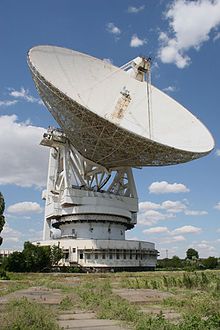
A radio telescope is a specialized antenna and radio receiver used to detect radio waves from astronomical radio sources in the sky. Radio telescopes are the main observing instrument used in radio astronomy, which studies the radio frequency portion of the electromagnetic spectrum emitted by astronomical objects, just as optical telescopes are the main observing instrument used in traditional optical astronomy which studies the light wave portion of the spectrum coming from astronomical objects. Unlike optical telescopes, radio telescopes can be used in the daytime as well as at night.

The Goldstone Deep Space Communications Complex (GDSCC), commonly called the Goldstone Observatory, is a satellite ground station located in Fort Irwin in the U.S. state of California. Operated by NASA's Jet Propulsion Laboratory (JPL), its main purpose is to track and communicate with interplanetary space missions. It is named after Goldstone, California, a nearby gold-mining ghost town.
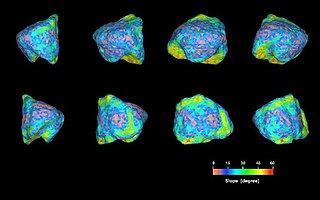
6489 Golevka is an Apollo, Mars-crosser, and Alinda asteroid discovered in 1991 by Eleanor F. Helin.

Yevpatoria is a city in Western Crimea, north of Kalamita Bay. Yevpatoria serves as the administrative center of Yevpatoria Municipality, one of the districts (raions) into which Crimea is divided. It had a population of 105,719 .
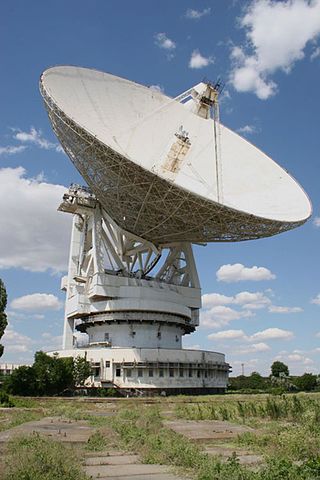
The Teen Age Message (TAM) was a series of interstellar radio transmissions sent from the Yevpatoria Planetary Radar to six solar-type stars during August–September 2001. The structure of the TAM was suggested by Alexander Zaitsev, Chief Scientist at Russia's Institute of Radio-engineering and Electronics. The message's content and target stars were selected by a group of teens from four Russian cities, who collaborated in person and via the Internet. Each transmission comprised three sections: a sounding, a live theremin concert, and digital data including images and text. TAM was humanity's fourth Active SETI broadcast and the first musical interstellar radio message.

(612901) 2004 XP14 is a sub-kilometer asteroid, classified as a near-Earth object and potentially hazardous asteroid of the Apollo group. It was first observed by the LINEAR project on 10 December 2004.

Aleksandr Leonidovich Zaitsev was a Russian and Soviet radio engineer and astronomer from Fryazino. He worked on radar astronomy devices, near-Earth asteroid radar research, and SETI.

The International Astrophysical Observatory "GRANAT", was a Soviet space observatory developed in collaboration with France, Denmark and Bulgaria. It was launched on 1 December 1989 aboard a Proton rocket and placed in a highly eccentric four-day orbit, of which three were devoted to observations. It operated for almost nine years.

Spektr-R was a Russian scientific satellite with a 10 m (33 ft) radio telescope on board. It was launched on 18 July 2011 on a Zenit-3F launcher from Baikonur Cosmodrome, and was designed to perform research on the structure and dynamics of radio sources within and beyond the Milky Way. Together with some of the largest ground-based radio telescopes, the Spektr-R formed interferometric baselines extending up to 350,000 km (220,000 mi).

The Yevpatoria RT-70 radio telescope is an RT-70 radio telescope and planetary radar at the Center for Deep Space Communications, Yevpatoria, Crimea. In scientific literature, it is often called the Evpatoria Planetary Radar (EPR).

The Galenki RT-70 radio telescope is an RT-70 telescope at the East Center for Deep Space Communications, Galenki (Ussuriysk), Russia.
The Suffa RT-70 radio telescope is an RT-70 radio telescope at the Suffa Radio Observatory on the Suffa plateau in Uzbekistan.
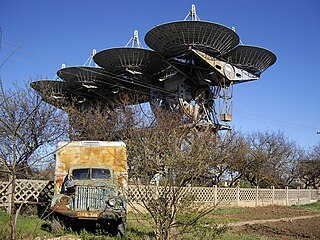
Pluton is a system of deep space communications and planetary radar in Crimea. It was built in the Deep Space Communication Center area 85th Radiotechnical Center of Distance Communications with Space Objects in the then Yevpatoria Raion in 1960.

Pushchino Radio Astronomy Observatory is a Russian radio astronomy observatory. It was developed by Lebedev Physical Institute (LPI), Russian Academy of Sciences within a span of twenty years. It was founded on April 11, 1956, and currently occupies 70 000 square meters.

The Chinese Deep Space Network (CDSN) is a network of large antennas and communication facilities that are used for radio astronomy, radar observations, and spacecraft missions of China. The CDSN is managed by the China Satellite Launch and Tracking Control Center General (CLTC) of the People's Liberation Army Strategic Support Force Space Systems Department.
The Soviet Deep Space Network is a network of large antennas and communication facilities that support interplanetary spacecraft missions, and radio and radar astronomy observations for the exploration of the Solar System and the universe during Soviet times. It was built to support the space missions of the Soviet Union. Similar networks are run by the USA, China, Europe, Japan, and India.
The Xinjiang Qitai 110m Radio Telescope (QTT) is a planned radio telescope to be built in Qitai County in Xinjiang, China. Upon completion, which is scheduled for 2028, it will be the world's largest fully steerable single-dish radio telescope. It is intended to operate at 150 MHz to 115 GHz. The construction of the antenna project is under the leadership of the Xinjiang Astronomical Observatory of the Chinese Academy of Sciences.
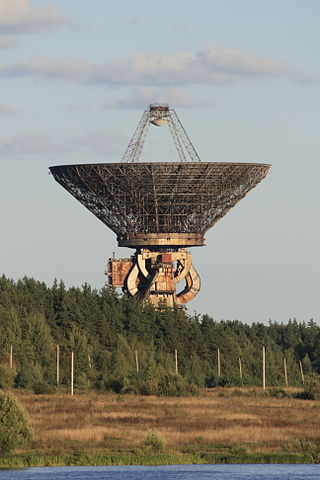
There are two radio telescopes designated RT-64 (TNA-1500), both in Russia and with similar specifications.

The National Space Facilities Control and Test Center is a Ukrainian state institution subordinate to the State Space Agency of Ukraine that manages space flight operations, deep space research using its own technical facilities, space monitoring, geophysical monitoring, and testing of space technology. After the annexation of Crimea, the headquarters of the center moved from Yevpatoria to Kyiv.
